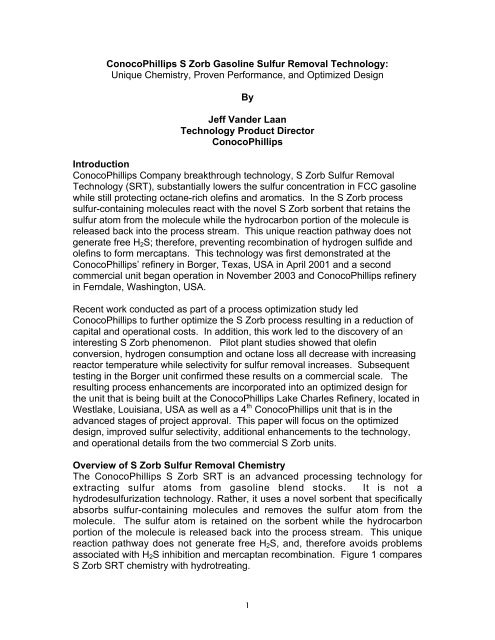1 ConocoPhillips S Zorb Gasoline Sulfur Removal Technology ...
1 ConocoPhillips S Zorb Gasoline Sulfur Removal Technology ...
1 ConocoPhillips S Zorb Gasoline Sulfur Removal Technology ...
You also want an ePaper? Increase the reach of your titles
YUMPU automatically turns print PDFs into web optimized ePapers that Google loves.
Figure 2. Comparison of relative reaction rates for different sulfurcompounds. The HDS data were taken from Hatanaka et al. (1).10RelativeReactivity for S <strong>Zorb</strong> SRT10.07.03.74.02.111.0ThiopheneC1-C2ThiophenesC3+ Thiophenes Alkyl-BenzothiophenesBenzothiopheneMercaptans& Sulfides10RelativeReactivity for HDS5.5 5.511.0 1.0ThiopheneC1-C2Thiophenes0.32.0C3+ Thiophenes Alkyl-Benzothiophene MercaptansBenzothiophenes& SulfidesThe ability to retain high sulfur conversion while minimizing olefin hydrogenationand the subsequent octane loss presents a significant advantage of S <strong>Zorb</strong> SRTover hydrotreating technologies, as shown in Figure 3. (HDS data are fromMcGuff (2) and S <strong>Zorb</strong> SRT data are from the Borger, Texas commercial unit.)3
1400 ppmw and produce product with less than 10 ppmw sulfur. This unit hasdemonstrated that S <strong>Zorb</strong> SRT is a proven, reliable, and flexible process for FCCNaphtha desulfurization.Table 1 – Comparison of typical performance of the Borger S <strong>Zorb</strong> unit vspilot plant results with Borger feedBorger S <strong>Zorb</strong> Unit Pilot PlantFeed sulfur, ppmw 248 218Product sulfur, ppmw 14 14<strong>Sulfur</strong> Conversion 94.4% 93.6%Octane Loss, Δ(R+M)/2 +0.1 -0.1Charge Rate, mtpd 750 0.14Reactor Temperature, C 400 413Reactor Pressure, kb/cm 2 g 9.3 10.6WHSV, hr -1 8.0 6.0Ferndale Refinery S <strong>Zorb</strong> unitThe largest commercial S <strong>Zorb</strong> SRT unit was brought on stream in the fourthquarter of 2003 at <strong>ConocoPhillips</strong> refinery in Ferndale, Washington, USA. The S<strong>Zorb</strong> unit was part of a refinery upgrade project that included the start up of anew fluidized catalytic cracking unit in the first quarter of 2003. The Ferndalerefinery has a crude oil processing capacity of 95,000 bpd. The S <strong>Zorb</strong> unit atFerndale has a design capacity of 20,000 bpd. It is designed to reduce the sulfurin a debutanized full range FCC gasoline stream from about 1,500 ppmw down to10 ppmw.The Ferndale S <strong>Zorb</strong> SRT unit was designed and constructed in 17 months andhas proven capable of running at its design capacity and meeting productspecifications. The startup of the S <strong>Zorb</strong> unit at Ferndale took place in Novemberof 2003 and was completed successfully and safely. The unit was commissionedahead of schedule and came in 10% under budget. <strong>Gasoline</strong> from the FCCdebutanizer bottoms was introduced to the S <strong>Zorb</strong> unit on November 15, 2003.Within 24 hours, the unit was running at design capacity. Sorbent regenerationbegan about 48 hours after gasoline was introduced into the unit. In less than 72hours, the S <strong>Zorb</strong> unit was stable at steady state conditions.9
Solids Transfer SectionThe solids transfer system, which moves sorbent to and from the reactor andregenerator systems, has been simplified. The use of one lockhopper system, asopposed to two-lockhopper operation, has resulted in lower capital requirementsand operating costs (lower nitrogen and hydrogen requirements) withoutcompromising operability, reliability, or safety. HAZOP reviews have beenconducted to assure the safe operation of the “One-Lockhopper System”. Theresults of the HAZOPs did not show any safety issues associated with thedesign.ReliabilityThe S <strong>Zorb</strong> process has the ability to shutdown and isolate the sorbentregeneration system long enough to perform typical maintenance tasks. Thisallows the reactor system to stay online at full charge making low sulfur product.One objective of the Process Optimization Study was to ensure that theoptimized design matched or exceeded current reliabilities. The ProcessOptimization team examined each section of the S <strong>Zorb</strong> process and maderecommendations to further improve unit reliability. In parallel with the ProcessOptimization Study, KBC Advanced Technologies Inc. was requested to performan independent reliability assessment for the optimized design. In particular,KBC was asked to compare S <strong>Zorb</strong> SRT reliability with hydrodesulfurizationreliability. KBC used their own methodology, equipment reliability database, andset all the reliability assumptions. They concluded that there was no significantdifference in reliability between S <strong>Zorb</strong> SRT and hydrodesulfurization.Conclusions and Future OutlookThe Ferndale unit’s safe and successful start-up and reliable performancedemonstrate the advantages of S <strong>Zorb</strong> SRT for desulfurization of gasolinestreams. The demonstrated commercial success at Ferndale is complementedby further reductions in capital and operating costs and improvements in thetechnology’s performance and reliability. A 38,500 bpd S <strong>Zorb</strong> unit featuringthese technical improvements is in the advanced stages of design/constructionfor the <strong>ConocoPhillips</strong> refinery at Lake Charles, Louisiana. The combined feedsulfur level is approximately 1,000 ppm and the unit is being designed to producea 10 ppm product. Startup of the S <strong>Zorb</strong> unit at Lake Charles is scheduled for late2005. In addition, a 4 th <strong>ConocoPhillips</strong> S <strong>Zorb</strong> unit is in the advanced stages ofproject definition and approval. The anticipated design throughput is around30,000 BPD and is targeted to start-up in late 2006.The future promises to bring continued downward pressure on the sulfur contentof gasoline even beyond the near term targets that have been established inmany countries around the world. S <strong>Zorb</strong> technology is strongly positioned toproduce fuels that comply with much more stringent sulfur regulations with little,12
or potentially no, octane loss, minimal hydrogen consumption, strong operatingreliability, and flexibility.<strong>ConocoPhillips</strong> is committed to an active technology development programfocused on additional enhancements to S <strong>Zorb</strong> SRT. These enhancementspromise to deliver additional improvement to the technology, including furtherimprovements to the impressive octane retention capability. Theseenhancements are expected to be available near term and are considered “dropin”improvements. So, the benefits are immediate requiring little or no capital toimplement.References1) S. Hatanaka, M. Yamada, and O. Sadakane, “Hydrodesulfurization ofCatalytic Cracked <strong>Gasoline</strong>. 1. Inhibiting Effects of Olefins on HDS ofAlkyl(benzo)thiophenes Contained in Catalytic Cracked <strong>Gasoline</strong>”, Ind.Eng. Chem. Res., 1997, 36, 1519-1523.2) Tim McGuff, “Ultra Low <strong>Sulfur</strong> <strong>Gasoline</strong> via Catalytic Distillation”, CDTech, GDS Seminar, July 18, 2001, Houston.13
















